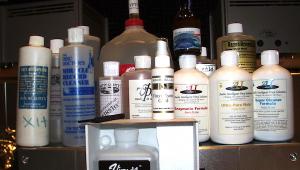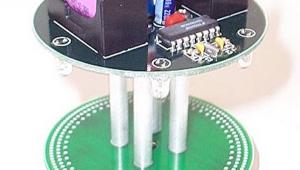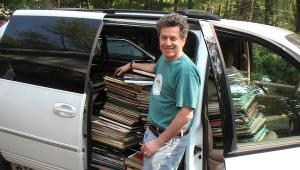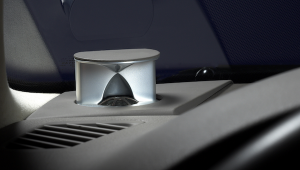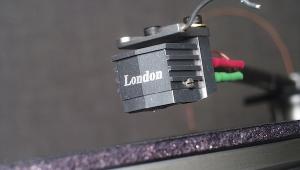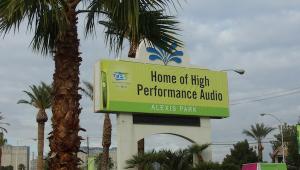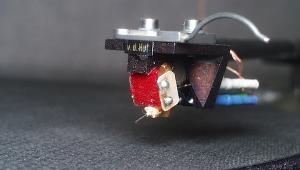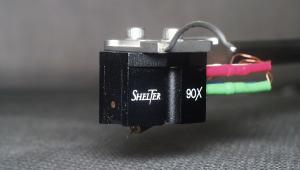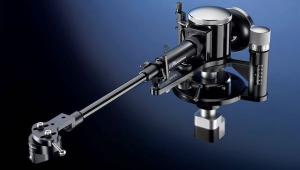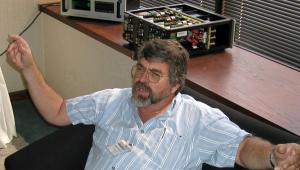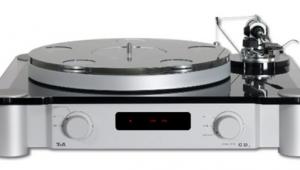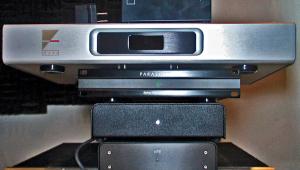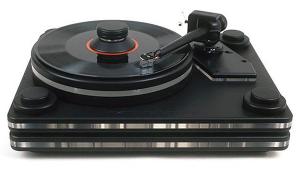In my semi retirement years I have found myself surrounded by academics who love the Times. They found this to be an egregious breach of the publice trust, i.e. sell out.
Analog Corner #50

(Originally published in Stereophile, September 12th, 1999)
After I saw my MP3 e-mail exchange with the editor of the "Circuits" section of the New York Times in the February Stereophile, I began to think that publishing it hadn't been such a great idea. If the exchange had burned my bridge to the Times, publishing it in this column had probably NATO-bombed it.
But eventually I made peace with my decision and forgot about it. Mikey vs the Times was a dead issue no matter what I did or didn't do, and at least Stereophile subscribers got to read what happened. Some of you thought it made the Times look bad, some of you thought it made me look like a hothead.
So, after all that, after explaining to the "Circuits" editor that, whatever benefits MP3 offers, "CD-quality" sound isn't among them, guess what appeared on the front page of the "Circuits" section of Thursday, June 17? An article titled "The Beat Goes on Line, and Sometimes It's Legal," by David Kushner, the lead sentence of which read "If there is a 'Phantom Menace' of the Internet, it's MP3, the compression software that enables CD-quality music to be sent on line. Like the film, MP3 comes with a considerable amount of hyperbole, promise and, alas, science fiction."
The guy labels MP3 "CD quality" and then writes about hyperbole! "CD quality" is the top banana, the commander in chief, the 300-lb gorilla, the Cadillac of MP3 hyperbole, Kushner. You butthead!
So of course I fired off another e-mail: Editor: David Kushner ("The Beat Goes on Line'') is correct in stating that "...MP3 comes with a considerable amount of hyperbole...'' Ironically, the most egregious example of it can be found in his lead sentence, wherein he states that MP3 offers "CD-quality" sound. Right. And Hyundai offers "BMW quality" transportation because it has four wheels and an engine.
[At HI-FI '99], I sat on a panel with Todd Moore, a representative of Diamond Multimedia, and he agreed that MP3 does not offer "CD-quality" sound. To anyone interested in a quality listening experience, MP3 does not even offer "near" CD sound, but that's an argument in degree that will be settled only by the individual doing the listening.
Please stop printing blatant misinformation on this subject.
Sincerely,
Michael Fremer
Senior Contributing Editor, Stereophile
A day after I sent it, I got an e-mail back telling me the section was "considering" printing my letter. That's nice, but what's called for as well is a "Correction" something like this: "An article in the June 17 'Circuits' stated that the compressed digital format known as MP3 offers 'CD-quality' sound. This is not true. The 'Circuits' editor had previously been given this information, but chose to publish the statement anyway."
That will never happen. The issue of whether MP3 is or is not "CD-quality sound" will be left as a matter of opinion. And that is too bad.
I've decided that MP3, though not of "CD quality," is a good thing for spreading new music, and poses no threat to quality audio. In fact, it could end up helping. How? I think back to the 1940s (before my time), when AM radio meant a large vacuum-tube–driven console with a 10" or 12" ported speaker. The sound wasn't "hi-fi," but it was rich and mellow.
Can you imagine a middle-aged someone brought up on that sound encountering a '50s teen carrying around a tinny, distorted-sounding six- or eight-transistor radio with a 1" speaker? "Sure, it's portable," the oldster would say, "but the sound is like fingernails on a chalkboard. How can you listen to that crap? No wonder you listen to rock'n'roll. You couldn't hear jazz on that." Sound familiar?
What happened when a generation brought up on those little tinny-sounding portables heard a real hi-fi? Right! The component boom of the '70s!
Byrds update
The other day I received test lacquers of The Byrds' Fifth Dimension and Younger Than Yesterday LPs from Sundazed Records. Like the first two (see the May "Analog Corner''), their sound was superb. Tomorrow I'll be receiving actual 180gm test pressings—if the results are favorable, they'll go into production immediately, and probably will be for sale by the time you read this. Watch for them.
But stay away from the Simply Vinyl Byrds LP reissues—they're not cut from master tapes, and the sound on Younger Than Yesterday (the only one I've heard) was truly awful. The Sundazed reissues, cut by Joe Palmaccio at Sony Studios using a Scully lathe/Neumann cutter-head combo, are the real deal—and "a bitch to cut analog," according to a Sundazed spokesperson.
Two budget phono sections compared!
Until now, the market for phono sections for less than $1000 has been owned, in my opinion, by the Lehmann Black Cube ($695—Stereophile October 1998, Vol.21 No.10). But the competition has heated up with the introduction of Musical Fidelity's X-LP2. And as I prepared for a shootout, what should show up but a new, improved Black Cube? The phono stage was set.
Both units were broken in using Thor Audio's Phono-Burn, even though the Musical Fidelity unit arrived ready to play, according to MF's Antony Michaelson, who hand-delivered it. After burn-in, both were left plugged in. The Black Cube was placed on Vibrapods.
The listening procedure was quite simple: I played each demo tune twice, once with each unit. Each phono section was set to 100 ohms input impedance, and maximum gain for the two low-output MC cartridges I used: an EMT TU2 special and a Clavis D.C. Of course, I ensured that levels were equal for both units, and made sure that each unit had a turn at first place in the rotation to account for sonic differences induced by vinyl fatigue.
I used Classic Records' 45rpm versions of Dave Brubeck's Time Out ("Take Five'') and Also sprach Zarathustra (part one), MoFi's reissue of Getz/Gilberto ("Girl from Ipanema''), Janis Ian's Breaking Silence ("All Roads to the River,''), and a mint British pressing of Elvis Costello's Punch the Clock ("Let Them All Talk''), among other selections. Audio Research's $6000 Reference phono section (currently under review) was my...reference.
The Lehmann Black Cube (Improved):
When I took the new Black Cube out of its box I was surprised by how lightweight it felt compared to the original review sample. What had the designer removed?
He'd changed the case to nonmagnetic aluminum and simplified the construction, removing two side walls of the chassis bottom. Circuit changes include a reconfigured, higher-voltage power supply and a new, supposedly better-sounding op-amp from Burr-Brown to replace the original one from Analog Devices. (For more circuit details, see the original review.)
Once the Black Cube was broken in, I hooked it up with some trepidation. I'd raved about the unit in my original review, comparing it to phono preamps costing twice as much. Now, spoiled by the Audio Research Reference, I wondered if I'd gotten completely carried away in that original review. Oops.
It took only a few seconds of "Take Five" to wake from that nightmare. The new Black Cube was every bit as good as I'd said the old one was. First, the soundstage moved off the speaker baffles and back to where I'm accustomed to hearing it. Second, the Cube returned a semblance of the rich, sophisticated tonal balance I'd become accustomed to with the ARC. Sounding neither solid-state nor tubey, the Cube, like the phono section built into the Ayre K-1, sounded appropriately colorless yet sweet and full-bodied.
The $695 phono section's high-frequency presentation was open, airy, and free of glare and grain. It was credible, and listenable without reservation. The Cube's dynamic performance—particularly in the bass—was as good as I'd remembered it being. There was weight, solidity, texture, and a pleasing sense of control that let me relax into the music.
The Cube's spatial performance was surefooted, with outstanding image focus and appropriate size. Three-dimensionality returned to the soundstage, and with it the kind of image layering one gets with far more expensive phono sections.
I chose Elvis Costello's "Let Them Talk" because of its musical complexity—there's a blaring horn section, an elegantly and appropriately large-sounding Bösendorfer piano, female background singers, and a driving drum-kit-and-electric-bass line, all expertly arranged and mixed by Clive Langer and Alan Winstanley.
The Cube delivered it all with certainty, separating the instruments spatially and tonally while portraying the music's dynamic rhythmic drive. No smearing, mashing, or mushing. The ARC Reference does it too, and even better—but look at the price difference!
The Black Cube was a tough, low-coloration act to follow—like closing for the Beatles—but that's where the Musical Fidelity X-LP2 was slotted to perform. On with the show.
The Musical Fidelity X-LP2 (A World Exclusive First Listen):
I covered the $295 X-LP in this column a while back (November 1997, Vol.20 No.11), and though it impressed me as a good value for the money and as an appropriate replacement for the Audio Alchemy VAC-in-the-Box (though it lacked the VAC's gain and loading options) and was therefore recommended, I wasn't able to work up a great deal of enthusiasm for it.
The three-chassis X-LP2 ($800) is something else entirely. It's a pure–dual-mono design—each channel has its own tubular chassis—and the outboard X-PSU power supply is essentially a large, high-current toroidal transformer with four sets of outputs. (This means that if you have another Musical Fidelity "X''-series product, you can plug it in as well.) I used the power supply with Musical Fidelity's X-24K 24-bit/96kHz DAC along with the X-LP2.
Compared with the X-LP, the X-LP2 is said to offer improved RIAA accuracy over a wider frequency range, improved signal/noise ratio, wider overload margin, and "perfect" imaging. According to the accompanying literature, the X-LP2 has "lower distortion, wider bandwidth, and better stereo separation than any cartridge on the market, therefore any sonic limitations are those of the cartridge, not the electronics." Hmm. Among the unit's more interesting specs is the high-frequency part of the RIAA equalization, which follows the implied curve out to 100kHz.
The back of each channel of the X-LP2 sports a pushbutton for switching between moving-coil and moving-magnet cartridges, an RCA output jack, and two input jacks: one each for MM and MC. There's also an MC loading switch that lets you choose between 100, 50, 25, and 10 ohms. Note that while 47k ohms is, of course, available at the MM input, if you wish to run your MC at 47k you're out of luck. (The same is true of the $6000 Audio Research Reference.)
The X-LP2 more than gives the Black Cube a run for its money. Both offer very similar overall sonic presentations, though the X-LP2 is slightly sweeter on top and a bit richer in the midbass, but not to the point of adding artificial warmth or a sluggish rhythmic disposition. Tonally, the X-LP2's performance renders solid-state/tube comparisons almost meaningless—which is precisely what I can say about the Audio Research Reference. (Though with better tubed phono sections you get a quality that I called "traction" in my review of the Conrad-Johnson Premier 15, and more "bloom" and liquidity.) The X-LP2 exhibited not a trace of hardness or etch on top, and the midrange was nicely fleshed out and harmonically complex.
The X-LP2's rendering of Classic's 45rpm version of Also sprach Zarathustra bettered the Black Cube's, particularly in the string tone, which was gloriously lush and full-bodied. The Black Cube, which has somewhat tighter, "faster" bass, did Costello with slightly more drive, though the X-LP2 did a great job of separating the instruments in space, and of capturing the tonal essence and weight of the Bösendorfer. Both did "Girl from Ipanema" equally well, getting Stan Getz's feathery sax to float convincingly in three-dimensional space.
Spatially, tonally, harmonically, and dynamically, the X-LP2 sounds as if it's worth $1600, not $800. If you're considering spending $2000 or under, don't buy anything until you hear it.
Once I'd finished taking notes for this comparison, I ended up leaving the X-LP2 in the system for over a week, so convincing and pleasing was its overall sonic presentation. I think it's in the same league as the Black Cube—and, for that matter, the $1200 phono-section option built into the Ayre K-1.
The X-LP2 might sacrifice a bit of air, sparkle, and "speed" on top to provide richness and freedom from grain and sibilance, but overall it's a brilliant balancing act that provides absolutely stunning analog performance at a very reasonable price. $800 for a three-chassis, dual-mono design with an outboard toroidal transformer? How can you beat that?
Wrap-Up:
The Lehmann Black Cube (www.hyendaudio.com) and the Musical Fidelity X-LP2 (available only via mail-order from Audio Advisor, www.audioadvisor.com) have surprisingly sophisticated power supplies and very high build qualities. I can't recommend one over the other because I could live happily with either, but if you play mostly classical music, go for the X-LP2; if you listen more to rock and jazz, go for the Cube. But do yourself a favor and find a way to hear both—the rest of your system will help you choose.
VPI SDS Synchronous Motor Drive System vs Walker Audio Precision Isolated Power Motor Drive
Either of these motor drives will probably improve the sound of your turntable if it's fitted with an AC synchronous motor, but in my listening sessions I found that they sounded different. Once the motor has reached its target rotational speed, the SDS steps the voltage down from 115V to your choice of eight values. It comes factory-set at 72V—the lowest setting—which is optimum for VPI turntables. (The idea is to drive the platter at the lowest possible motor voltage for minimum noise and vibration.)
But 72V proved too low for the small Simon Yorke motor, which operates at 96V via a step-down transformer and drives a 24-lb platter. I could hand-turn the platter to get it going, but just touching it would kill the sync and the motor would begin fibrillating. For some reason I could not program the SDS for 96V and have it "hold" the setting, so while waiting for a second sample, I listened at 72V. The SDS ($1000) sounded slightly more liquid than the Walker drive ($1500), which had a slight overlay of grain, but the Walker stomped the SDS dynamically and provided blacker blacks and more solid imaging.
A second SDS arrived, set for 96V. This was sufficient to keep sync even if I touched the platter with my finger, and I conducted another set of listening comparisons. This time the two drives performed about equally dynamically, but the SDS retained its edge in terms of liquidity. It just sounded sweeter.
Then, for some reason, the SDS reverted to 72V. By switching to 45rpm and then back, sometimes it would revert to 96V. But as I write this it's back to 72V no matter what I do. Currently in the system, however, is the Basis Debut, which reaches and holds sync at 72V with no problem. The Debut seems to sound marginally better with the SDS.
Given the cost difference, I'd recommend the SDS, but I'm concerned about the voltage-drop problem if you plan on using the SDS with other turntables. So is Harry Weisfeld, who can't explain it either. He's working on it. If you're a VPI owner, I'm confident you'll hear a genuine sonic improvement well worth the $1000.
Coming
I owe you a cartridge survey that I hope to get to next time, along with a report on Classic Records' spectacular-sounding 45rpm limited-edition reissues.
- Log in or register to post comments

The machine of Ledmannaudio is same my product's blogthietbidinhviadsun. Originally published in Stereophile verry cool
